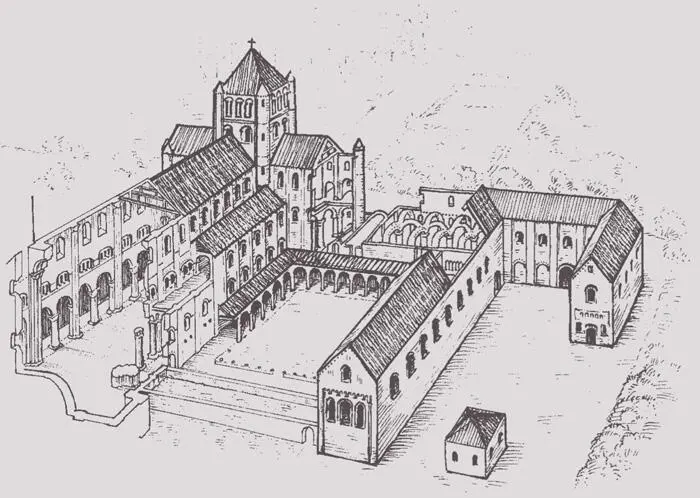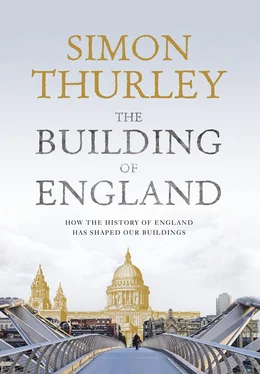Most rubble walls were originally plastered inside and out, concealing the original construction method. This provided a canvas for surface decoration as seen at towers such as All Saints’, Earls Barton, or St Peter’s, Barton-upon-Humber ( figs 29and 31). This decoration, whilst imitating Roman arcades and pilasters, was easily applied and constructed using the principles of joinery. Even the baluster window openings at All Saints’ were conceived in the language of wood turning rather than masons’ work. 33Thus the role of carpenters in construction was crucial. They built the shuttering for wall construction and scaffolding as the building rose, in addition to the roofs (many of which were covered in timber shingles), doors, windows, balconies, staircases and other internal fittings. Moreover, the decoration of these structures was imagined in the mind of a carpenter not a mason. Finally, it is vital to acknowledge the increasingly important role of the smith in construction. Smiths were highly valued, largely through their role of arming men in a military society. Yet buildings increasingly demanded both decorative ironwork and more functional bars, cramps and hinges.
Fig. 32 God witnessing the building of the tower of Babel; a manuscript from St Augustine’s Monastery, Canterbury, Kent from the second quarter of the 11th century. This is a rare glimpse of Saxon workmen with their tools erecting a complex building (from The Old English Illustrated Hexateuch , c .1125–50, British Library. Shelfmark: Cotton Claudius B. IV, f. 19).
The Viking raids shook English society and stimulated the growth of the state. First the Mercians, then the West Saxons, mobilised labour and materials to reshape society and the very landscape of England. The country was divided into 32 shires, at least 20 of which took their names from burghs, which became centres of royal power and administration. Beneath these were smaller administrative units: hundreds in the south and west, and wapentakes in the north and east, the focus for justice and tax collection. The only exception was the north, which was only brought into the system after the Norman Conquest.
As the administrative matrix of England was created from above, so parishes formed from below. Instead of holding all the land themselves, kings granted it to their followers, who became the first generation of estate-owning English squires. These men built themselves fortified houses and founded churches and, across much of lowland England, this stimulated the move from dispersed settlements to villages. People’s religious focus and loyalty also moved from the minsters to new parishes in both town and country. The sense of identity these changes created is of huge importance; by 1000 it was not only England that existed but also a sense of Englishness among its inhabitants. These were big changes and they were accompanied by important architectural developments. Alongside a timber-building tradition that was part Roman and part Saxon, a vigorous stone tradition developed. In this, before the 1040s, English buildings were eclectic combinations of strong insular traditions, themselves established through a mix of Romano-British and Saxon forms – with influences from Carolingian Europe – producing an architecture that was wholly English. 34
There was, however, a strong underlying continuity. Although life had become more complex both economically and socially, rich and poor still lived in single-cell dwellings. Peasants, either in villages or in isolated houses or hamlets, lived in a single room in which they would cook, eat and sleep. Although their social and economic superiors had separate structures for communal entertainment, worship and cooking, they also lived in a single room, albeit constructed more robustly and decorated in the current fashion. This fact continued to be the foundation of everyday life for some centuries to come.
| As the first generation of Normans died out, England’s architecture was already looking very different to anything in their former homelands ... they might not have been able to express it in 1130, but the Normans and their architecture were becoming English. |
| Although King Alfred’s dynasty succeeded in forging a single English state, it could not eliminate the threat from foreign predators. As a result, the kingdom was overthrown in the 1010s by the Danes, and from 1019 England became part of a Scandinavian empire ruled by King Cnut and his sons for 26 years. The house of Wessex was only restored in 1042 with the accession of Edward the Confessor. By this date England, as a unified kingdom, was one of the best-developed monarchies in Europe and probably the richest. It had a strong currency and efficient taxation, effective administration, laws and judicial system, more than 100 towns, and was home to some of the largest and most sophisticated buildings in northern Europe. |
| The conquest of the English state by the Danish kings prefigured the Norman Conquest by half a century. That William of Normandy’s success lived on where Cnut’s conquest was short-lived was a result of the stability, strength and close proximity of the Norman homeland. Yet for a quarter of a century the cultural orientation of England bent towards Scandinavia, opening the way for architectural and decorative influences. It is sometimes possible to detect these in sculpture and the decorative arts, but harder in architecture. It is likely, though, that the distinctive round towers of parish churches in Norfolk and Suffolk can be connected with missionaries coming from Saxony after the Danish invasions, but this is an isolated example, and the enduring architectural impact of the second Viking era was limited. 1 |
| Edward the Confessor |
| The same cannot be said for the reign of Edward the Confessor, who commissioned one of the most influential buildings in English architectural history. Edward’s outlook was cosmopolitan. His mother was the daughter of the Count of Normandy and Edward had been brought up in the Norman court for 25 years. Out of a plethora of claimants for the English throne Edward was eventually crowned in 1043 and ruled, with some success, for 23 years. It was soon after his accession that he decided to build a new palace and abbey at Westminster. This was a break with tradition for, as a son of Wessex, Edward had been crowned at Winchester Cathedral, the burial place of his ancestors and his Danish predecessors. By the 1040s, however, London was the most important and populous city in England. It occupied a key defensive position, had the largest mint, was the biggest port, and contributed more in tax than anywhere else. Moreover, its citizens had taken a role in the acclamation of kings, choosing Edmund Ironside in 1016 and Edward himself in 1042. Edward was a realist and he saw that London, not Winchester, was now the key to the kingdom. His new palace and abbey, both built – presumably for security – outside the city, created a powerful royal enclave next to England’s commercial and political capital. The thoroughness and scale of the enterprise were startling. The existing minster was entirely demolished, new quarries were opened up at Reigate and craftsmen were assembled from all over England. Building was underway before 1050, but whilst the east end was ready to receive the Confessor’s body in 1065 the whole abbey was not completed until about 1080. The abbey church was enormous, about 322ft long, larger than anything built in England since the Romans, and larger than any church in northern Europe at the time. This reflected Edward’s wealth and his desire to establish, in London, a royal dynastic centre to rival if not surpass Winchester. 2 |
 |
| Fig. 33 Conjectural reconstruction of Edward the Confessor’s Westminster Abbey showing in cut-a-way the nave arcades. This was a new way of building in England transforming the three-dimensional experience of internal space. |
| The Confessor’s Westminster Abbey sent English architecture in a wholly new direction. The abbey had no direct precedent in England or Normandy, although, across the Channel, the Norman abbey of Jumièges was being constructed in a similar style almost simultaneously. Both the English and the Normans were in fact imitating a way of building invented in Burgundy, and developed there and in the Loire valley in the 1030s and 40s. The essential change was from interiors that relied for their effect on large areas of painted wall surface to spaces that were modelled in three dimensions, with arches, horizontal mouldings (string courses), semicircular shafts, stone vaults and ornamental mouldings. These ideas essentially came from Roman buildings, especially the large and prominent remains of amphitheatres with their tiers of arches and columns. 3 |
Fig. 34 St Mary in Castro, Dover Castle, Kent. Standing next to the Roman lighthouse that dates from the early 2nd century is a Saxon church, itself substantially built of re-used Roman materials. It was once linked to the lighthouse which was probably used as its bell tower. Its location at the centre of an important fortified burgh together with high-level patronage meant that it was one of the most substantial churches of its age.
Читать дальше













